|
|
"Dry canal" across Nicaragua breathes new life into old dream
|
|
|
|
|
International consortium plans mega-project
|
|
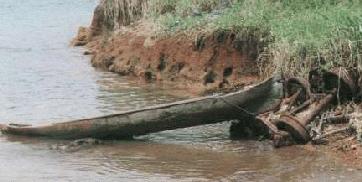
|
|
Photo: Peter Costantini
|
|
|
Old railroad wheels on the beach at Monkey Point
|
|
|
|
|
|
|
|
By Peter Costantini
|
|
MANAGUA — Half-buried in the sand of an isolated, palm-fringed Caribbean beach, a few old railroad wheels lie rusting. They were left at Monkey Point in 1903, local people say, by some Germans who started building a railroad across Nicaragua. They never got far, though. The project foundered, and in 1910 the U. S. Marines landed to put an end to Nicaragua's commercial flirtations with Europe and Japan.
|
|
|
|
|
|
This summer, nearly a century later, U.S. engineering firm Parsons Brinckerhoff began a $20 million feasibility study of a "dry canal" or "land bridge" across Nicaragua. The $1.4 billion project, scheduled to break ground next year, will construct deep-water container ports and free-trade zones on the Caribbean and Pacific and connect them with a 210-mile high-speed railroad. The Caribbean terminus will be located at Monkey Point.
"Nicaragua is open for business with the rest of the world," said Don Bosco, president of the private consortium that will build and run the system. The project reflects Nicaraguans "hopes and aspirations for the future," he said. For North Americans, it should reduce shipping costs and thus "benefit the consumer and important export companies."
Since 1567, when King Philip II of Spain ordered a study of a wet canal across Nicaragua, the idea has resurfaced repeatedly. As prospectors en route to the California gold fields in the 1850s traveled up the San Juan River and across Lake Nicaragua, the U.S. military considered digging a canal there. In 1902, however, Panama won out over Nicaragua after a Panamanian lobbyist mounted a scare campaign in the U.S. Senate featuring a Nicaraguan stamp of a volcano erupting. Recent proposals for a Nicaraguan wet canal have been rejected as too costly and environmentally damaging.
|
|
|
|
|
|
In contrast, the current dry canal proposal looks less controversial. Although it faces competition from proposed land bridges across other parts of Mesoamerica, it enjoys support across the Nicaraguan political spectrum and indifference in Washington. "If you get an economically viable dry canal that reduces transportation costs, that creates jobs and employment in a place like this, what's there to be against?" said a U.S. diplomat in Managua, speaking on condition of anonymity. "It's good for trade, it helps prevent illegal immigration to the States."
|
|
|
|
Sitting on the dock of the bay in the Caribbean port of Bluefields, Nicaragua
|
|
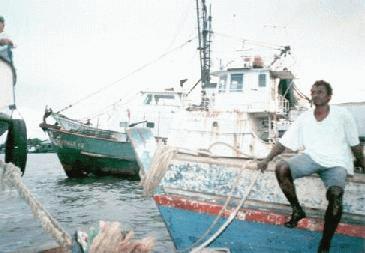
|
|
Photo: Peter Costantini
|
Once again, financial backing for the project is coming mainly from European and East Asian firms. But this time, the riptides of global trade have eroded the Monroe Doctrine, which claimed Latin America as the United States' "backyard." Latin America countries are increasingly looking east and west for trade and investment.
The Nicaraguan plan may reap advantages from the geopolitical and economic competition between the People's Republic of China and Taiwan, which has invested heavily in Central America. Chinese and Hong Kong port, construction and shipping firms have joined the dry canal consortium, which could offer China an economic counterweight in the region.
|
|
|
|
Container cranes unloading a ship in the port of Seattle
|
|
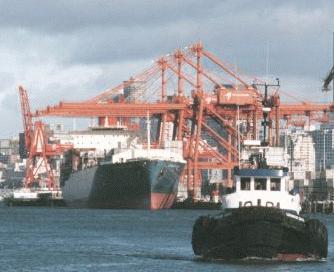
|
|
Photo: Linda Becker
|
Container trade booms
|
|
|
|
|
|
The seeds of the dry canal plan germinated in the fertile container tradebetween Asia, North America and Europe, which since 1990 has increased 6 to 8 percent yearly. The aging Panama Canal, which still carries five percent of world shipping, will revert to Panamanian management in 2000. It has become a bottleneck, with waits of several days common. The bigger container ships now being built, known as post-Panamax, are too big to fit through the Canal's locks.
|
|
|
|
‘The international interests that are moving cargo between the Far East and the U.S. and Europe see that the opportunity to have alternatives to the Canal is really critical. Because the canal has some major inefficiencies in it.’
— Emil Combe
economic consultant
|
|
For container traffic, which tends to carry higher-value and more perishable cargoes, the U.S. land bridge has grown in the last twenty years into a faster but more expensive alternative to the Canal. Depending on the route and the cargo's shelf life, shippers can save time by using more rail or truck, or save money by going further on water. Consumer electronics from Korea, for example, can appear on shelves on the East Coast up to a week earlier — for about $500 more per container — if shipped to Tacoma or Oakland and rapidly loaded onto double-stack railcars for the rest of the trip.
Bosco said the route across Nicaragua to the U.S. East Coast could cut the U.S. land bridge's $1,500 to $2,000 per container price tag nearly in half, while remaining "competitive" on shipping time. Some transport analysts, though, said U.S. railroads are in strong financial shape and will be formidable competitors.
Over the past ten years, explained economic consultant Emil Combe, a lot of manufacturing and commerce has migrated southward from Japan to the booming region from Shanghai south to Indonesia. For containerized cargo heading from southeastern Asia to the eastern U.S. and Latin America, he said, a sea-land-sea route across Central America might prove profitable. Shippers could gain economies of scale by moving product across the Pacific in big post-Panamaxes, transferring it into smaller feeder vessels at both ends of the dry canal for journeys north, south and east. This is the market of which the Nicaraguan dry canal hopes to capture a slice.
|
|
|
|
|
|
The dry canal consortium, known by its Spanish initials CINN, claims as members major construction, railroad, port operations and shipping firms from seven European countries, Brazil and east Asia. Parsons Brinckerhoff of New York, which calls itself the world's largest transportation engineering firm, is heading the feasibility study.
A strong signal
|
|
|
|
|
|

|

|

|
|
|

|
Juan Carlos Rivas on environmental effects of the dry canal
in English
en español
(RealAudio sound and text of quote)
|
|
|
Bosco said he envisions the railroad as "kind of a spinal cord across the country," along which commerce and light industry can develop. If successful, the dry canal will send a strong signal to foreign investors that Nicaragua welcomes them, said Juan Carlos Rivas, a Nicaraguan then executive director of the consortium. "It will change forever the image of Nicaragua as an unstable, conflict-plagued country, to one of a country at peace and in full development." Rivas has since left the consortium.
While neither opposing nor supporting the dry canal, Hector Mairena of the Nicaraguan Environmental Movement faulted both CINN and the government for failing to encourage more public participation on the issue. Because the project transcends the interests of one government or generation, he said, the whole society needs to be involved in examining the social and environmental costs, perhaps through a national referendum.
|
|
|
|
|
|
"Poverty is Nicaragua's principal environmental problem," Mairena said. "Neither the Suez Canal nor the Panama Canal solved the problems of poverty in those countries. Poverty plus the resulting destruction of the environment and natural resources to survive equals more poverty. So it turns into a vicious circle, which we have to break."
The planned railroad will pass through a volcanic zone and near a rain forest preserve, and the ports will be located not far from coral reefs in the Caribbean and sea turtle nesting beaches on the Pacific. According to Parsons Brinckerhoff vice president Paul Gilbert, the feasibility study will address economic, social and environmental impacts, along with engineering and market issues. And the consortium, he said, will work to minimize the project's negative side effects.
|
|
|
|
The Escondido River coils through the Nicaraguan jungle. The proposed route of the dry canal railroad passes to the south.
|
|
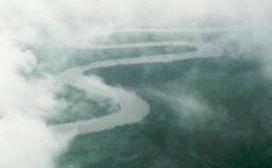 |
|
Photo: Peter Costantini
|
|
|
|
|
|
|
The United Nations Development Program has agreed to work with the consortium and the Nicaraguan government to facilitate studies of the project's environmental, economic and social consequences, said Nicola Harrington, UNDP deputy director in Managua. According to Bosco, the collaboration will be the agency's first with a private firm.
After years of dictatorship followed by land reforms, unclear land ownership complicates the leasing or buying of land in some areas. "I'm looking for a clear, unambiguous right-of-way," said Gilbert. "At the peak of construction, which will last about two years, we'll be putting between one and two million dollars a day in the ground. So we want it clear."
Skepticism about project's chances
Beyond environmental concerns, some analysts are skeptical about the project's economic prospects. "There's an unfortunate tendency in Central America to look very strongly at their comparative advantages," said Costa Rica-based transport economist Warren Crowther. "From this point of view Nicaragua sounds like a dream. But when you get to see what all the other players are doing and what your competitors can come up with, I really wonder."
"These same outfits came here with the idea of selling the Costa Ricans big on this," he said. "My own hypothesis is that these guys are really more interested in getting feasibility studies done and getting consulting fees than in getting any dry canal done." Responded Bosco: "I don't make any money on the studies. I have to break my tail to go out and raise the money for the studies."
|
|
|
|
|
|
Mexico and Panama are upgrading their infrastructure, Crowther observed, and U.S. land bridges are expanding into Latin America.
Indeed, Panama, with existing port facilities and a coast-to-coast distance about a quarter that of Nicaragua's, may hold most of the trump cards in the dry canal game. Kansas City Southern Railroad is negotiating with the Panamanian government to build a new railroad line on an abandoned right-of-way.
At Manzanillo on Panama's Caribbean coast, Stevedoring Services of America's new $120-million container terminal is thriving. In the past three years, said managing director Andy McLauchlan, larger vessels and increased competition have nearly halved costs per container from Asia to Panama.
|
|
|
|
|
|
Mexico, too, may offer attractive land-bridge alternatives and big local markets if it can modernize its ports and railroads. American President Lines uses Manzanillo on the Pacific as a major port of entry for cargo from Asia, which it ships and trucks primarily into the U.S. Midwest, according to vice president Joaquín Montalván.
In southeastern Mexico, the ports of Coatzacoalcos and Salina Cruz and an old railroad across the Isthmus of Tehuantepec are functional but in poor condition. Plans to modernize the facilities for containers, however, have been clouded by anti-government guerrillas in the region and alleged efforts by a cocaine-trafficking cartel to buy the two ports.
In the other Central American countries and Colombia, dry and wet canal proposals have circulated for years. But none have advanced as far as Nicaragua's. Costa Rica recently rejected the idea as too expensive and incompatible with its ecotourism industry.
|
|
|
|
Poor roads make oxcarts a practical form of transport in parts of rural Nicaragua.
|
|
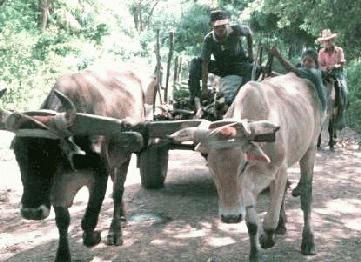
|
|
Photo: Peter Costantini
|
Dreams of development
|
|
|
|
|
|
In Nicaragua, by contrast, the government has welcomed the dry canal. According to Bosco, the project also has the support of opposition leader Daniel Ortega.
Many Nicaraguans across the political spectrum look to the dry canal as an economic cornucopia — newspapers there have claimed it will create 20,000 jobs. After construction, Bosco estimated, the dry canal's permanent operations will employ 6,000 to 7,000, with each direct position generating another two or three support jobs.
|
|
|
|
|
|
With unemployment over 50 percent and 70 percent of Nicaraguans living in poverty, a common response to questions about the project was to rub thumb against index and middle fingers to indicate the cash they hoped the project would spread around.
Francisco Campbell, member of the Central American Parliament, said training and good jobs were the key to insuring that the project benefits local people. "What does it mean in terms of employment possibilities for our people?" he asked. "Not only the cheap labor component. We need to not only guarantee jobs in the building of this canal, but also to insure that it means long-term employment for our people over an indefinite period of time."
In the isolated spots where the new ports and free trade zones will be built from scratch, nearly everybody survives on subsistence farming and fishing. Most people are desperate for the jobs and economic development they expect the project to bring.
In the village of El Gigante, site of the proposed Pacific port, some saw new roads as a boon in getting their produce or catch to market.
|
|
|
|
|
|
At Monkey Point on the Caribbean, in a region where some 80 percent are unemployed, many welcomed the prospect of more work and better transportation. But most of the English-speaking Creole people and Rama Indians who live there have no title to their land, which they hold in common. Some fear that the mega-project will elbow them aside and pave over their traditional ways of life.
|
|
|
|
|
|
"Sure the dry canal is coming, but then it mustn't molest the Indians," said Angela Benjamin MacRae, a Rama Indian, in English. "Leave the Indians to them place. My parents were born right here, right here." And her neighbor, Cristina Nat, added in Rama: "We're not against the canal, but we want our rights and our homes."
Recently, residents said, some unknown men from the Pacific side of Nicaragua showed up, claimed they owned a tract of land there, and tried to set up a sawmill. In the past, more than one dictator has given titles to tracts of Caribbean wilderness as repayment for favors.
Registered nurse Pearl Watson is organizing her neighbors to work with the government to survey their traditional lands and secure a clear communal title. Community members should not sell their land, she said, but rather offer the dry canal a long-term lease and use the revenue to fund local schools and health care.
Such concerns do not appear to trouble the many Nicaraguans who are pinning their hopes of economic revival on foreign investment and for whom the canal project appears an blessing bestowed on them by global markets. The full implications of the project, though, are still unfolding for a nation which has seen too many dreams deferred and promises broken.
|
|
|
|
Father and son walk on the beach at Monkey Point.
|
|
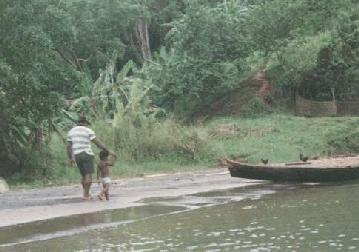
|
|
Photo: Peter Costantini
|
Peter Costantini reported on the October 1996 elections in Nicaragua for MSNBC News. He is Seattle correspondent for Inter Press Service, a newswire based in Rome.
|
|
| |
|
To play the audio clips and slide/audio shows for this story, you need the Real Audio player, free at 
|
|